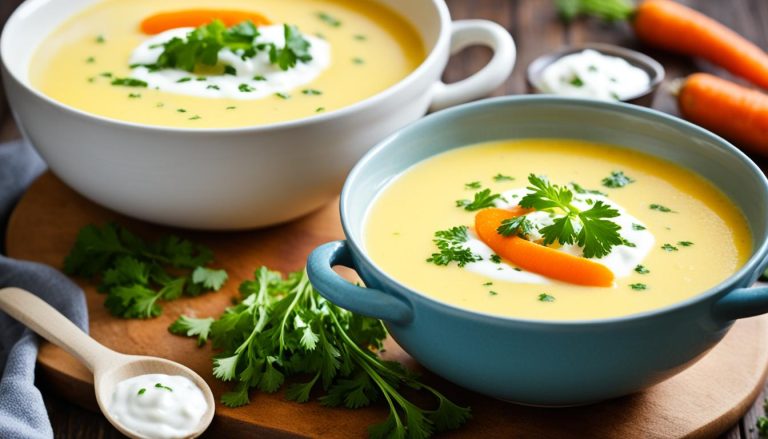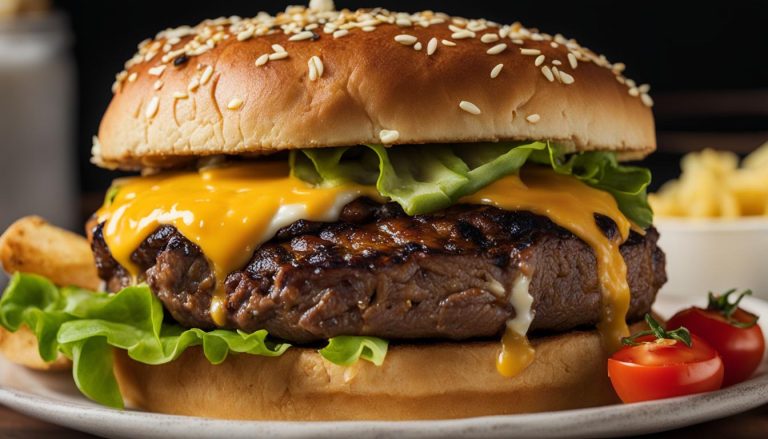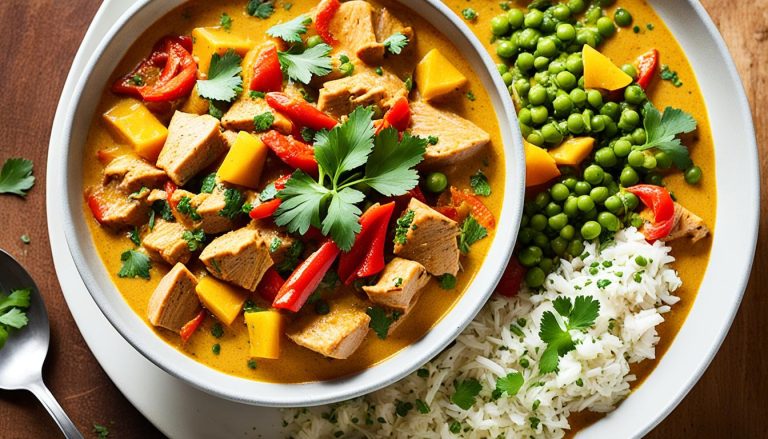Welcome to our classic homemade gumbo recipe! If you’re craving a taste of Louisiana, then this authentic gumbo recipe is perfect for you. Made with a dark roux, vegetables, chicken, sausage, and shrimp, this gumbo is packed with flavor and warmth. Whether you’re a seasoned cook or a beginner, our easy steps will guide you through the process of creating a delicious gumbo that will impress your family and friends.
Let’s dive into the world of gumbo and discover the wonders of this beloved Louisiana dish. From understanding the differences between gumbo and jambalaya to mastering the art of making a roux, we’ll cover everything you need to know to create an authentic gumbo from scratch. So grab your apron and let’s get cooking!
What is Gumbo and How is it Different from Jambalaya?
Gumbo and jambalaya are beloved dishes in Louisiana cuisine, each with its own unique characteristics. While they may share some similar ingredients, they are distinct in their cooking process, flavors, and overall presentation.
Gumbo is a hearty stew that originated in Louisiana. It typically consists of a dark roux, which is made by cooking flour and oil until it reaches a rich, brown color. This roux serves as the base for the gumbo, providing a deep, savory flavor and thickening the stew. Cajun gumbo, often associated with rural areas of Louisiana, features ingredients like chicken and sausage, while Creole gumbo, associated with New Orleans, includes seafood such as shrimp and crab.
Jambalaya, on the other hand, is a rice-based dish that is often referred to as “red jambalaya” due to its vibrant color. It is typically made by sautéing meat, such as chicken, sausage, or seafood, with vegetables and spices, and then adding rice and broth. The mixture is simmered until the rice absorbs the flavors of the other ingredients, resulting in a flavorful and aromatic one-pot meal.
| Gumbo | Jambalaya |
|---|---|
| Thick stew | Rice-based dish |
| Dark roux | Sautéed meat and vegetables |
| Chicken, sausage, and/or seafood | Chicken, sausage, and/or seafood |
| Distinct Cajun and Creole variations | Various regional and personal variations |
While gumbo and jambalaya may have similar components, their cooking processes and resulting flavors make them distinctly different dishes. Gumbo offers a thick, stew-like texture with a deep, rich flavor derived from the dark roux and assortment of meats. Jambalaya, on the other hand, combines sautéed meats, vegetables, and spices with rice, resulting in a flavorful one-pot meal.
If you’re looking to master the art of traditional gumbo, this is the recipe for you. Keep reading to discover the step-by-step guide to making an authentic gumbo that will transport you to the heart of Louisiana.

The Key to a Perfect Gumbo Recipe: The Roux
The roux is an essential component in any gumbo recipe. It is created by heating a combination of flour and oil together until it transitions into a dark brown color and achieves the consistency of dough. This painstaking process is what imparts a deep, rich flavor to the gumbo, while also providing it with its signature thickness. While it does require time and patience, mastering the art of making roux is well worth the effort in the end.
To prepare the roux, take a large pot and combine flour and oil in it. Cook the mixture over medium-low heat, carefully stirring constantly. This will ensure even cooking and prevent any burning. The goal is to reach a desired dark brown color, which can take around 30 minutes to achieve. Remember to exercise caution and avoid splattering as the roux cooks and thickens. Once you have obtained the perfect dark roux, you can proceed with adding it to your gumbo recipe.

Making your own roux at home allows you to have complete control over its flavor and thickness. Whether you prefer a lighter roux or a darker one, the choice is in your hands. Experiment with different ratios of flour to oil until you find the perfect balance for your taste. The roux serves as the foundation for a mouthwatering gumbo that will satisfy your cravings for authentic Louisiana cuisine.
Step-by-Step Guide to Making Authentic Gumbo
Follow these easy steps to make an authentic gumbo:
Step 1: Gather Your Ingredients
To make a delicious homemade gumbo, you will need the following ingredients:
- 1 cup flour
- 1 cup oil (such as vegetable or canola oil)
- 1 onion, chopped
- 1 green bell pepper, chopped
- 2 celery stalks, chopped
- 3 cloves of garlic, minced
- 1 pound chicken thighs, boneless and skinless, cut into bite-sized pieces
- 1 pound smoked sausage, sliced
- 1 pound shrimp, peeled and deveined
- 1 can diced tomatoes, undrained
- 4 cups chicken broth
- 2 bay leaves
- 2 teaspoons Cajun seasoning
- Salt and pepper to taste
- Chopped green onions for garnish
Step 2: Make the Roux
The roux is the foundation of a gumbo. In a large pot, heat the oil over medium heat. Add the flour and stir continuously until it turns a dark brown color, similar to the color of chocolate. This usually takes about 15-20 minutes. Be careful not to burn the roux, as it will give your gumbo a bitter taste.
Step 3: Saute the Vegetables
Add the chopped onion, bell pepper, celery, and garlic to the pot with the roux. Cook until the vegetables are soft and translucent, about 5 minutes.
Step 4: Add the Meats and Seasonings
Add the chicken and sausage to the pot and cook until the chicken is browned on all sides, about 5-7 minutes. Season with Cajun seasoning, salt, and pepper. Stir in the diced tomatoes, bay leaves, and chicken broth.
Step 5: Simmer and Skim
Bring the gumbo to a boil, then reduce the heat and let it simmer for 30 minutes to an hour. Skim off any fat or impurities that rise to the surface during cooking.
Step 6: Add the Shrimp
Once the gumbo has simmered, add the shrimp and cook for an additional 5 minutes, or until the shrimp turn pink and opaque.
Step 7: Serve and Enjoy
Remove the bay leaves from the gumbo. Serve hot over cooked rice and garnish with chopped green onions. Enjoy your homemade chicken and sausage gumbo or seafood gumbo!
Now that you have the step-by-step guide, it’s time to roll up your sleeves and start cooking. Your family and friends will be impressed with your homemade gumbo skills!
Tips for Making the Best Gumbo
Creating a delicious gumbo requires attention to detail and a few key tips. Here are some expert gumbo tips to help you perfect your homemade gumbo recipe:
1. Use Quality Ingredients
Start with the freshest ingredients possible. Opt for high-quality proteins such as fresh shrimp, tender chicken, and flavorful sausage. Additionally, choose fresh vegetables and aromatic spices to enhance the overall flavor profile of your gumbo.
2. Balance the Flavors
Gumbo is all about creating a harmonious blend of flavors. Make sure to balance the richness of the roux with the right amount of salt, spices, and herbs. Keep tasting as you cook and adjust the seasonings to your preference.
3. Don’t Rush the Roux
The roux is the foundation of a good gumbo. Take your time and cook the roux over low heat to achieve a deep, rich color. Stir constantly to prevent burning and create a smooth texture.
4. Stir Properly
When adding the roux to the gumbo, make sure to stir it thoroughly into the liquid. This helps to distribute the flavors and ensures a consistent texture throughout the dish.
5. Simmer Slowly
Gumbo is best cooked slowly over low heat. Allow the flavors to meld together by simmering the gumbo for an extended period. This will result in tender meats and a flavorful, thickened sauce.
6. Let It Rest
After cooking, let the gumbo rest for a short period to allow the flavors to develop further. This resting time allows the ingredients to marry together and enhances the overall taste of the gumbo.
“Creating a delicious gumbo requires attention to detail and a few key tips.”
By following these gumbo tips and incorporating them into your homemade gumbo recipe, you’ll be able to create a mouthwatering dish that impresses your family and friends.

Make-Ahead, Storing, and Freezing Instructions
Preparing gumbo in advance can be a time-saving strategy, allowing you to enjoy this delectable dish with minimal effort. Additionally, knowing how to store and freeze gumbo properly ensures that none of this flavorful goodness goes to waste. Follow these instructions to make-ahead, store, and freeze your gumbo:
Make-Ahead Instructions
- Prepare the roux according to the recipe instructions.
- Allow the roux to cool completely.
- Transfer the cooled roux to an airtight container and store it in the refrigerator for up to 5 days.
- When you’re ready to make your gumbo, simply take out the roux from the refrigerator and proceed with the recipe as directed. This will save you valuable time and effort during the cooking process.
Storing Instructions
Leftover gumbo should be stored properly to maintain its freshness and flavor. Follow these guidelines:
- Cover the gumbo tightly with a lid or plastic wrap.
- Place the covered gumbo in the refrigerator.
- The gumbo can be stored in the refrigerator for 3-4 days.
- Before reheating, make sure to bring the gumbo to room temperature.
Freezing Instructions
If you have more gumbo than you can consume within a few days, freezing is a great option for preserving its taste and texture. Here’s how to freeze gumbo:
- Allow the gumbo to cool completely.
- Transfer the gumbo to a freezer-safe container or freezer bags.
- Remove as much air as possible from the container or bags to prevent freezer burn.
- Label the container or bags with the date and contents.
- Store the gumbo in the freezer for up to 2-3 months.
To reheat the frozen gumbo:
- Thaw the gumbo overnight in the refrigerator.
- Once thawed, heat the gumbo on the stove or in the microwave until it reaches the desired temperature.
Now that you know how to make-ahead, store, and freeze gumbo, you can enjoy this delightful dish whenever you please. Whether you’re planning ahead or looking to use up leftovers, these instructions ensure that the gumbo retains its incredible flavors and delightful textures. So go ahead and savor every spoonful of your homemade gumbo, knowing that you’ve mastered the art of preserving its deliciousness.
Similar Recipes to Try
If you enjoyed this gumbo recipe, consider trying these related recipes for more delicious gumbo variations and gumbo-inspired dishes:
- Gumbo with Okra and Shrimp: This variation of gumbo incorporates the classic combination of okra and shrimp, adding a unique texture and flavor to the dish. It’s perfect for seafood lovers who want a taste of Louisiana.
- Chicken and Sausage Gumbo: If you prefer a heartier gumbo, give this chicken and sausage variation a try. The savory combination of tender chicken and flavorful sausage will satisfy any craving.
- Vegetarian Gumbo: For those looking for a meat-free alternative, this vegetarian gumbo recipe is packed with delicious vegetables and aromatic herbs and spices. It’s a flavorful option that everyone can enjoy.
- Gumbo Pot Pie: Take your gumbo to the next level by turning it into a delectable pot pie. The combination of a rich gumbo filling and a flaky pie crust creates a comforting and satisfying dish.
- Gumbo Stuffed Peppers: Add a twist to your gumbo experience by stuffing bell peppers with a gumbo-inspired filling. The peppers become tender and fragrant as they bake, creating a delightful meal.
Try these recipes to explore the diverse world of gumbo and discover new and exciting flavor combinations. Whether you’re a gumbo connoisseur or just starting your gumbo journey, these recipes are sure to impress.
Gumbo with Okra and Shrimp
This gumbo variation combines the classic flavors of okra and shrimp to create a rich and flavorful dish. The okra adds a distinctive sliminess and the shrimp brings a delicate seafood taste to the gumbo. Serve it over a bed of fluffy rice for a complete and satisfying meal.
| Ingredients: | Instructions: |
|---|---|
|
|
Conclusion
Making a homemade gumbo is a labour of love, but the end result is a comforting and flavourful dish that is worth the effort. This classic gumbo recipe captures the essence of Louisiana cuisine and will transport you to the heart of New Orleans. Follow the step-by-step instructions and tips provided to create a delicious gumbo that will impress your family and friends.









